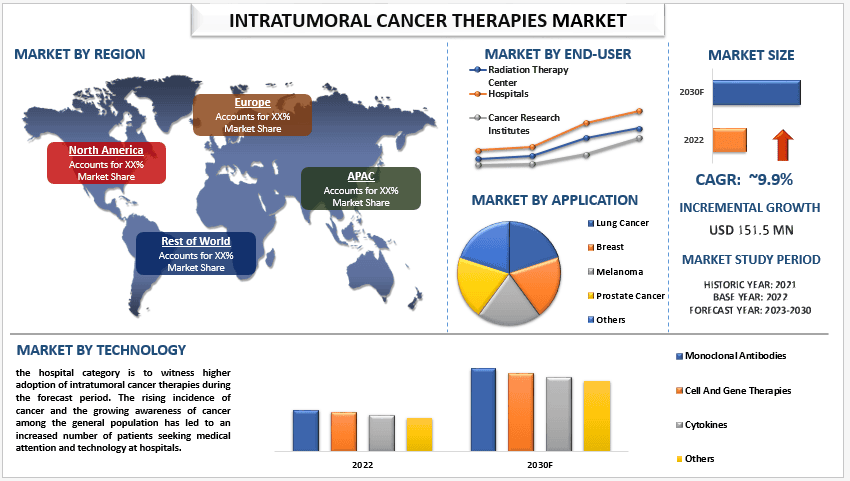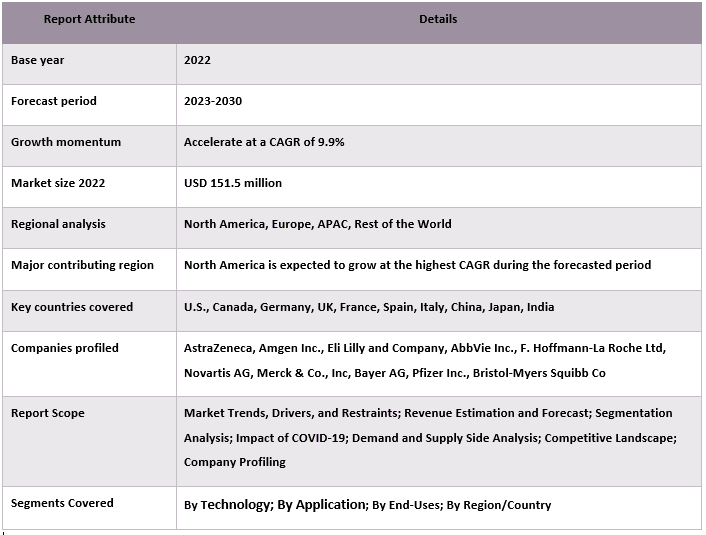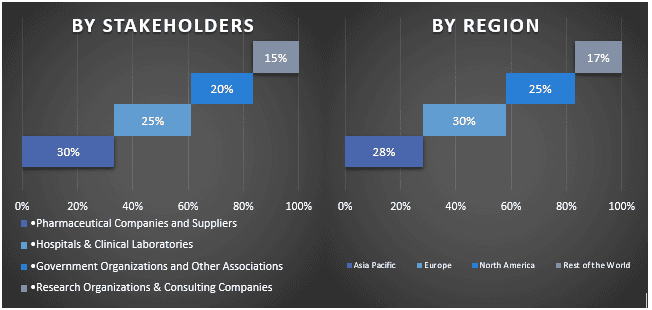- Home
- Chi siamo
- Settore
- Servizi
- Lettura
- Contattaci
Mercato delle terapie intratumorali per il cancro: analisi attuale e previsioni (2023-2030)
Enfasi sulla tecnologia (anticorpi monoclonali, terapie cellulari e geniche, citochine, altro); Applicazione (cancro del polmone, cancro al seno, melanoma, cancro alla prostata, altro); Utenti finali (ospedali, centri di radioterapia, istituti di ricerca sul cancro); e Regione/Paese

Il mercato delle terapie antitumorali intratumorali è stato valutato a 151,5 milioni di dollari nel 2022 e si prevede che crescerà a un CAGR del 9,9% dal 2023 al 2030. Le terapie antitumorali intratumorali sono un tipo di trattamento del cancro che prevede la somministrazione di agenti terapeutici direttamente nel sito tumorale. A differenza dei trattamenti sistemici, che circolano in tutto il corpo, le terapie intratumorali prendono di mira le cellule tumorali all'interno del tumore, riducendo al minimo l'esposizione ai tessuti sani. I crescenti progressi nell'immunoterapia, compresi gli inibitori dei checkpoint immunitari, le terapie con cellule CAR-T e i virus oncolitici, stanno guidando l'interesse per le applicazioni intratumorali. Queste terapie stimolano la risposta immunitaria dell'organismo per colpire e distruggere le cellule tumorali direttamente all'interno del sito tumorale. Ad esempio, nel febbraio 2021, la FDA ha approvato Keytruda (pembrolizumab) di Merck per il trattamento del cancro alla vescica non muscolo-invasivo ad alto rischio che non risponde alla terapia BCG. Questa approvazione evidenzia il potenziale delle immunoterapie nelle applicazioni intratumorali. Inoltre, la tendenza verso la medicina personalizzata sta guidando lo sviluppo di terapie intratumorali personalizzate in base ai profili genetici e alle caratteristiche tumorali dei singoli pazienti. Questo approccio migliora l'efficacia del trattamento e riduce gli effetti collaterali.
Alcuni dei principali attori che operano sul mercato sono AstraZeneca, Amgen Inc., Eli Lilly and Company, AbbVie Inc., F. Hoffmann-La Roche Ltd, Novartis AG, Merck & Co., Inc, Bayer AG, Pfizer Inc., Bristol-Myers Squibb Co. Diverse fusioni e acquisizioni insieme a partnership sono state intraprese da questi attori per fornire ai clienti prodotti/tecnologie hi-tech e innovativi.
Approfondimenti presentati nel rapporto
“Tra le tecnologie, il segmento degli anticorpi monoclonali ha detenuto una quota significativa del mercato nel 2022.”
Sulla base della tecnologia, il mercato è stato suddiviso in anticorpi monoclonali, terapie geniche e cellulari, citochine e altri. Tra questi, il segmento degli anticorpi monoclonali dovrebbe crescere a un CAGR più elevato nel mercato grazie al loro potenziale di colpire cellule tumorali specifiche, innescare risposte immunitarie e ridurre al minimo gli effetti off-target. Gli anticorpi monoclonali sono stati ampiamente utilizzati nei trattamenti sistemici contro il cancro e la loro applicazione nelle terapie intratumorali sta guadagnando terreno grazie alla loro precisione ed efficacia. Ad esempio, l'anticorpo farmaco-coniugato di GSK, Blenrep (belantamab mafodotin-blmf), ha ottenuto l'approvazione della FDA per il trattamento del mieloma multiplo recidivato o refrattario.
“Tra le applicazioni, il segmento del cancro ai polmoni ha detenuto una quota significativa del mercato nel 2022.”
Sulla base dell'applicazione, il mercato è stato suddiviso in cancro ai polmoni, seno, melanoma, cancro alla prostata e altri. Tra questi, il segmento del cancro ai polmoni dovrebbe crescere a un CAGR più elevato nel mercato a causa dell'alta incidenza del cancro ai polmoni e della crescente adozione di terapie innovative per affrontare questa malattia impegnativa. Inoltre, i trattamenti standard per il cancro ai polmoni, come la chirurgia, la chemioterapia e le radiazioni, possono avere limitazioni e effetti collaterali significativi. Le terapie intratumorali mirano ad affrontare queste sfide prendendo di mira le cellule tumorali riducendo al minimo i danni ai tessuti sani. Ad esempio, nel 2021, Varian Medical Systems sta sviluppando tecniche innovative per il trattamento localizzato del NSCLC, comprese le terapie intratumorali denominate Elekta. Queste tecniche mirano a colpire i tumori all'interno del polmone riducendo al minimo i danni al tessuto polmonare sano.
“Tra gli utenti finali, il segmento degli ospedali ha registrato il CAGR più elevato nel mercato nel 2022.”
Sulla base dell'utente finale, il mercato è stato suddiviso in ospedali, centri di radioterapia e istituti di ricerca sul cancro. Tra questi, la categoria ospedaliera dovrebbe assistere a una maggiore adozione di terapie antitumorali intratumorali durante il periodo di previsione. La crescente incidenza del cancro e la crescente consapevolezza del cancro tra la popolazione generale hanno portato a un aumento del numero di pazienti che cercano cure mediche e tecnologia negli ospedali. Inoltre, gli ospedali offrono un approccio multidisciplinare riunendo vari specialisti come endocrinologi, chirurghi oncologi, oncologi medici, radiologi e patologi per fornire cure complete e personalizzate ai pazienti oncologici. Inoltre, gli ospedali spesso dispongono di team chirurgici esperti nell'esecuzione di interventi chirurgici complessi alla tiroide, tra cui la tiroidectomia totale e la dissezione dei linfonodi, che sono essenziali nella gestione del cancro.
“Il Nord America ha dominato il mercato delle terapie antitumorali intratumorali nel 2022.”
Si prevede che il mercato delle terapie antitumorali intratumorali del Nord America continuerà a crescere nei prossimi anni, guidato dalla crescente prevalenza del cancro e dalla crescente consapevolezza delle terapie antitumorali intratumorali tra gli operatori sanitari e la popolazione generale, dallo sviluppo di tecniche di imaging avanzate e dall'aumento delle opzioni di trattamento. Ad esempio, nel 2020, secondo l'American Cancer Society, il cancro è la seconda causa di morte più comune negli Stati Uniti, superata solo dalle malattie cardiache. negli Stati Uniti si prevedono circa 609.360 decessi per cancro nel 2022, ovvero circa 1.670 decessi al giorno.
Copertura del rapporto sul mercato delle terapie antitumorali intratumorali

Motivi per acquistare questo rapporto:
- Lo studio include l'analisi delle dimensioni del mercato e delle previsioni convalidate da esperti chiave del settore autenticati.
- Il rapporto presenta una rapida panoramica della performance complessiva del settore a colpo d'occhio.
- Il rapporto copre un'analisi approfondita dei principali operatori del settore con un focus primario sulle principali informazioni finanziarie aziendali, sui portafogli di prodotti, sulle strategie di espansione e sugli sviluppi recenti.
- Esame dettagliato dei fattori trainanti, dei vincoli, delle tendenze chiave e delle opportunità prevalenti nel settore.
- Lo studio copre in modo completo il mercato attraverso diversi segmenti.
- Analisi approfondita a livello regionale del settore.
Opzioni di personalizzazione:
Il mercato globale delle terapie antitumorali intratumorali può essere ulteriormente personalizzato in base alle esigenze o a qualsiasi altro segmento di mercato. Inoltre, UMI comprende che potresti avere le tue esigenze aziendali, quindi sentiti libero di metterti in contatto con noi per ottenere un rapporto che si adatti completamente alle tue esigenze.
Indice
Metodologia di ricerca per l'analisi del mercato delle terapie intratumorali contro il cancro (2023-2030)
L'analisi del mercato storico, la stima del mercato attuale e la previsione del mercato futuro del mercato globale delle terapie intratumorali contro il cancro sono stati i tre passaggi principali intrapresi per creare e analizzare l'adozione delle terapie intratumorali contro il cancro nelle principali regioni a livello globale. È stata condotta un'esaustiva ricerca secondaria per raccogliere i dati storici del mercato e stimare le dimensioni attuali del mercato. In secondo luogo, per convalidare queste informazioni, sono state prese in considerazione numerose scoperte e ipotesi. Inoltre, sono state condotte anche esaurienti interviste primarie con esperti del settore lungo tutta la catena del valore del mercato globale delle terapie intratumorali contro il cancro. Dopo l'ipotesi e la convalida dei dati di mercato attraverso interviste primarie, abbiamo impiegato un approccio top-down/bottom-up per prevedere le dimensioni complete del mercato. Successivamente, sono stati adottati metodi di suddivisione del mercato e di triangolazione dei dati per stimare e analizzare le dimensioni del mercato dei segmenti e dei sottosegmenti del settore di riferimento. La metodologia dettagliata è spiegata di seguito:
Analisi delle dimensioni storiche del mercato
Passaggio 1: studio approfondito delle fonti secondarie:
È stato condotto uno studio secondario dettagliato per ottenere le dimensioni storiche del mercato delle terapie intratumorali contro il cancro attraverso fonti interne all'azienda come relazioni annuali e bilanci, presentazioni sulle prestazioni, comunicati stampa, ecc. e fonti esterne tra cui riviste, notizie e articoli, pubblicazioni governative, pubblicazioni dei concorrenti, relazioni di settore, database di terze parti e altre pubblicazioni credibili.
Passaggio 2: segmentazione del mercato:
Dopo aver ottenuto le dimensioni storiche del mercato delle terapie intratumorali contro il cancro, abbiamo condotto un'analisi secondaria dettagliata per raccogliere informazioni storiche sul mercato e condividere diversi segmenti e sottosegmenti per le principali regioni. I principali segmenti inclusi nel report sono tecnologia, applicazione e utenti finali. Sono state condotte ulteriori analisi a livello di paese per valutare l'adozione complessiva dei modelli di test in quella regione.
Passaggio 3: analisi dei fattori:
Dopo aver acquisito le dimensioni storiche del mercato di diversi segmenti e sottosegmenti, abbiamo condotto una dettagliata analisi dei fattori per stimare le dimensioni attuali del mercato delle terapie intratumorali contro il cancro. Inoltre, abbiamo condotto un'analisi dei fattori utilizzando variabili dipendenti e indipendenti come tecnologia, applicazione e utenti finali del mercato delle terapie intratumorali contro il cancro. È stata condotta un'analisi approfondita degli scenari di domanda e offerta considerando le principali partnership, fusioni e acquisizioni, espansioni aziendali e lanci di prodotti nel settore del mercato delle terapie intratumorali contro il cancro in tutto il mondo.
Stima e previsione delle dimensioni attuali del mercato
Dimensionamento attuale del mercato: sulla base di informazioni fruibili dai 3 passaggi precedenti, siamo giunti alle dimensioni attuali del mercato, ai principali attori nel mercato globale delle terapie intratumorali contro il cancro e alle quote di mercato dei segmenti. Tutte le quote percentuali richieste e le suddivisioni del mercato sono state determinate utilizzando l'approccio secondario sopra menzionato e sono state verificate attraverso interviste primarie.
Stima e previsione: per la stima e la previsione del mercato, sono stati assegnati pesi diversi a fattori diversi, inclusi fattori trainanti e tendenze, vincoli e opportunità disponibili per le parti interessate. Dopo aver analizzato questi fattori, sono state applicate tecniche di previsione pertinenti, ovvero l'approccio top-down/bottom-up, per arrivare alla previsione di mercato per il 2030 per diversi segmenti e sottosegmenti nei principali mercati a livello globale. La metodologia di ricerca adottata per stimare le dimensioni del mercato comprende:
- Le dimensioni del mercato del settore, in termini di entrate (USD) e il tasso di adozione del mercato delle terapie intratumorali contro il cancro nei principali mercati a livello nazionale
- Tutte le quote percentuali, le suddivisioni e le ripartizioni dei segmenti e sottosegmenti di mercato
- Attori chiave nel mercato globale delle terapie intratumorali contro il cancro in termini di prodotti offerti. Inoltre, le strategie di crescita adottate da questi attori per competere nel mercato in rapida crescita
Convalida delle dimensioni e della quota di mercato
Ricerca primaria: sono state condotte interviste approfondite con i Key Opinion Leader (KOL) tra cui Top Level Executives (CXO/VP, Responsabile vendite, Responsabile marketing, Responsabile operativo, Responsabile regionale, Responsabile paese, ecc.) nelle principali regioni. I risultati della ricerca primaria sono stati quindi riassunti ed è stata eseguita un'analisi statistica per dimostrare l'ipotesi dichiarata. I dati della ricerca primaria sono stati consolidati con i risultati secondari, trasformando così le informazioni in informazioni fruibili.
Ripartizione dei partecipanti primari nelle diverse regioni

Ingegneria del mercato
La tecnica di triangolazione dei dati è stata impiegata per completare la stima complessiva del mercato e per arrivare a dati statistici precisi per ogni segmento e sottosegmento del mercato globale delle terapie intratumorali contro il cancro. I dati sono stati suddivisi in diversi segmenti e sottosegmenti dopo aver studiato vari parametri e tendenze nelle aree della tecnologia, dell'applicazione e degli utenti finali nel mercato globale delle terapie intratumorali contro il cancro.
L'obiettivo principale dello studio sul mercato globale delle terapie intratumorali contro il cancro
Le attuali e future tendenze del mercato globale delle terapie intratumorali contro il cancro sono state individuate nello studio. Gli investitori possono ottenere informazioni strategiche per basare la propria discrezione per gli investimenti sull'analisi qualitativa e quantitativa eseguita nello studio. Le tendenze attuali e future del mercato hanno determinato l'attrattiva complessiva del mercato a livello regionale, fornendo una piattaforma per il partecipante industriale per sfruttare il mercato non sfruttato per beneficiare di un vantaggio di first-mover. Altri obiettivi quantitativi degli studi includono:
- Analizzare le dimensioni attuali e previste del mercato delle terapie intratumorali contro il cancro in termini di valore (USD). Inoltre, analizzare le dimensioni attuali e previste del mercato di diversi segmenti e sottosegmenti
- I segmenti nello studio includono aree della tecnologia, dell'applicazione e degli utenti finali
- Definire e analizzare il quadro normativo per l'industria delle terapie intratumorali contro il cancro
- Analizzare la catena del valore coinvolta con la presenza di vari intermediari, insieme all'analisi dei comportamenti dei clienti e dei concorrenti del settore
- Analizzare le dimensioni attuali e previste del mercato delle terapie intratumorali contro il cancro per la regione principale
- I principali paesi delle regioni studiati nel report includono Asia Pacifico, Europa, Nord America e il resto del mondo
- Profili aziendali del mercato delle terapie intratumorali contro il cancro e le strategie di crescita adottate dagli operatori di mercato per sostenersi nel mercato in rapida crescita
- Analisi approfondita a livello regionale del settore
Correlati Report
I clienti che hanno acquistato questo articolo hanno acquistato anche










